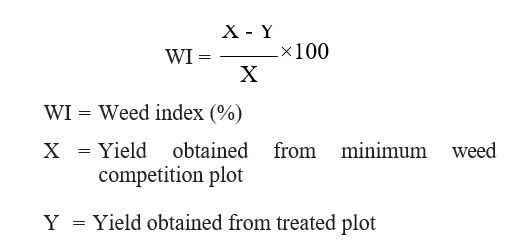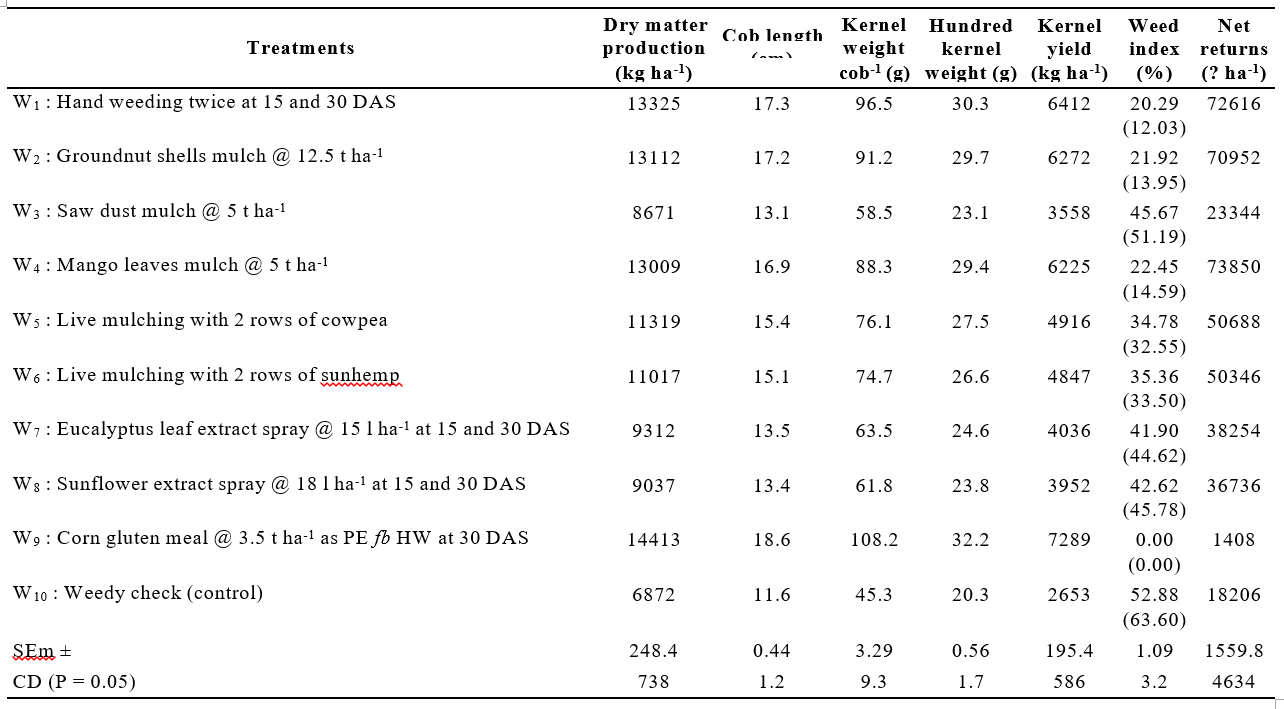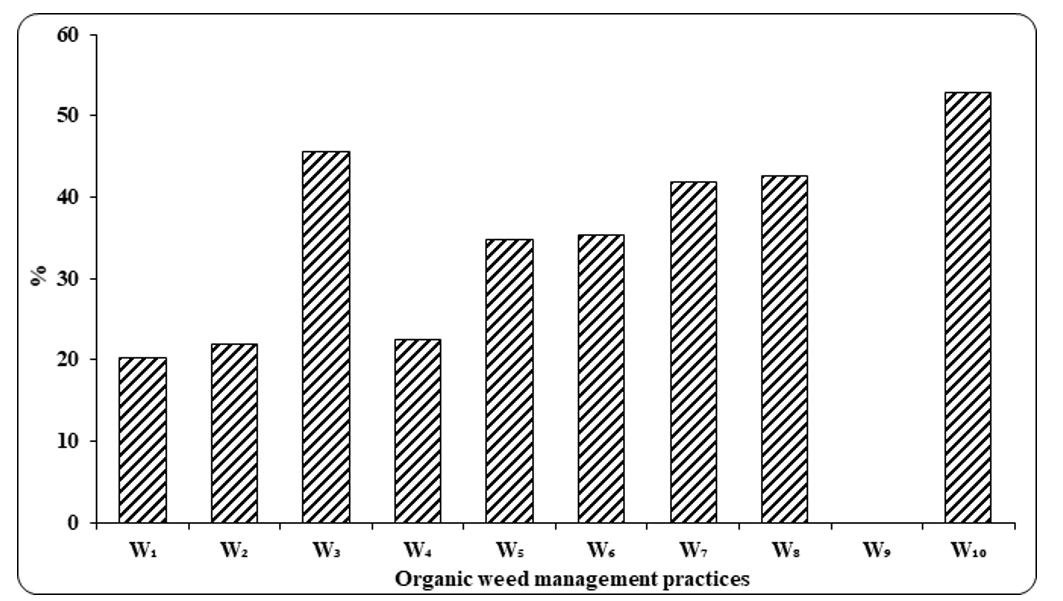INTRODUCTION
Maize (Zea mays L.) is considered as queen of the cereals and is one of the most important crop next to rice and wheat in global agriculture. Maize is grown in 194 million ha area over more than 170 countries across the globe with 1148 million MT of production (2020-21). Among the maize growing countries, India ranks 4th in area and 7th in production representing around 4 per cent of world maize area and 2 per cent of total production. During 2020-21 in India, it is grown in 9.89 million ha area with 31.65 million tonnes of production and with a productivity of 3199 kg ha-1 (Anonymous, 2021).
Maize being a widely spaced crop, gets infested with number of weeds and subjected to heavy weed competition which often causes huge losses in yield ranging from 28 to 100 per cent (Patel et al., 2006). Maize is sensitive to weeds especially during early stages of development and thus weed infestation from germination to 45 DAS causes maximum reduction in yield.
Modern agriculture is productivity oriented and depends mainly on synthetic inputs namely herbicides to manage the weeds. Continuous non-judicious use of herbicides for weed management will cause loss of biodiversity, environmental pollution and develops herbicide resistance in weeds. However in the current scenario of agriculture, evolving an eco- friendly, sustainable and economical approach of weed management is more advisable so as to protect our environmental resources such as soil flora and fauna including human being and animals in a holistic manner. Organic crop growers face weed control as their greatest difficulty in crop production because they are not allowed to use chemical herbicides. Hence, a strong need was felt to find the non-chemical methods of weed management practices in organic maize production system.
MATERIAL AND METHODS
A field experiment was conducted during rabi season of 2021-22 at Wetland Farm, S.V. Agricultural College, Tirupati, located at 13.5°N latitude and 79.5°E longitude with an altitude of 182.9 m above mean sea level in the Southern Agroclimatic Zone of Andhra Pradesh, India. The soil was sandy clay loam in texture, neutral in soil reaction, low in organic carbon and available nitrogen, and medium in available phosphorus and potassium. The experiment was laidout in randomized block design with ten weed management practices and three replications. The treatments consisted of hand weeding twice at 15 and 30 DAS (W1), groundnut shells mulch @ 12.5 t ha-1 (W2), saw dust mulch @ 5 t ha-1 (W3), mango leaves
mulch @ 5 t ha-1 (W4), live mulching with 2 rows of cowpea (W5), live mulching with 2 rows of sunhemp (W6), eucalyptus leaf extract spray @ 15 l ha-1 at 15 and 30 DAS (W7), sunflower extract spray @ 18 l ha-1 at 15 and 30 DAS (W8), corn gluten meal 3.5 t ha-1 as PE fb HW at 30 DAS (W9) and weedy check (W10).
Maize hybrid ‘DHM-117’ was raised with recommended package of practices except for the weed management practices. The crop was sown on 26th October, 2022 and recommended dose of fertilizers was 240-80-80 kg N, P2O5 and K2O ha-1. Full dose of phosphorous and potassium were applied as basal and nitrogen was applied in three equal splits viz., 1/3rd as basal, 1/3rd at knee high stage and the remaining 1/3rd at tasseling stage. Weed management practices were imposed as per the treatments. The different organic mulches were applied on the day of sowing in between the rows of maize. Live mulches were grown up to 40 DAS, uprooted and spread on the soil surface. The required quantities of filtered concentrated plant water extracts were sprayed at 15 and 30 DAS. Data on different parameters were recorded and statistically analyzed following the analysis of variance for RBD as given by Panse and Sukhatme (1985). Weed index was calculated by employing formula given by Tripathi et al., (1971).

RESULTS AND DISCUSSION
Weed flora
The weed flora associated with maize belongs to thirteen taxonomic families, of which the predominant weed species were Dactyloctenium aegyptium (L.) Willd (36.00%), Cyperus rotundus L. (22.00%), Digitaria sanguinalis (L.) Scop. (18.00%), Boerhavia erecta L. (11.00%), Commelina benghalensis L. (6.00%), Euphor- bia hirta L. (3.00%) and others (4.00%).
Effect of organic weed management practices on maize
The results revealed that different organic weed management practices significantly improved the dry matter accumulation, cob length, kernel weight cob-1, hundred kernel weight, kernel yield and net returns over weedy check (Table 1).
Dry matter production
Dry matter production of maize at harvest was significantly influenced by various organic weed management practices (Table 1). Dry matter production was significantly higher with corn gluten meal @ 3.5 t ha-1 as PE fb HW at 30 DAS (W9) over rest of the treatments at harvest of maize. The higher dry matter accumulation in W9 is might be due to pre emergence herbicidal activity of corn gluten meal, that have controlled weeds in the initial stages of the crop growth and later emerged weeds were effectively removed by hand weeding imposed at 30 DAS and it also contains 10 per cent nitrogen content by weight, which might have accelerated the plant growth and is reflected as higher dry matter. The next best treatment was hand weeding twice at 15 and 30 DAS (W1), however which was at par with groundnut shells mulch @ 12.5 t ha-1 (W2) and mango leaves mulch @ 5 t ha-1 (W4). The higher dry matter was owing to significant reduction in density and dry matter of weeds that helps for greater penetration of solar radiation in the crop canopy, higher rate of photosynthesis and more accumulation of dry matter. Similar findings were also reported by Stanzen et al. (2017). Significantly lower dry matter production was registered with weedy check (W10) due to heavy weed infestation lead to shorter plant height with less foliage and dry matter production.
Yield attributes and Yield
Cob length, kernel weight cob-1, hundred kernel weight and kernel yield of maize differed significantly due to organic weed management practices (Table 1).
Higher yield attributes viz., cob length, kernel weight cob-1 and hundred kernel weight and kernel yield of maize were registered with corn gluten meal @ 3.5 t ha-1 as PE fb HW at 30 DAS (W9), which was significantly superior over rest of the treatments. Hand weeding twice at 15 and 30 DAS (W1) was the next best, however it was at par with groundnut shells mulch @ 12.5 t ha-1 (W2) and mango leaves mulch @ 5 t ha-1 (W4). This might be
Table 1. Growth, yield attributes, kernel yield, weed index and net returns of maize as influenced by organic weed management practices


Figure 1. Weed index (%) of maize as influenced by organic weed management practices
due to lower crop weed competition for growth resources throughout the crop growing period enabling the crop for maximum utilization of nutrients, moisture, light and space, which enhanced the vegetative and reproductive potential of the crop that might have reflected in the form of higher yield attributes and kernel yield of maize. Similar results were also reported by Mahto et al. (2020), Stanzen et al. (2017) and Barad et al. (2016). Yield attributes and kernel yield were significantly lower with weedy check (W10) when compared to rest of the weed management practices.
Weed index
Weed index refers to yield reduction due to presence of weeds in comparison to the best weed management practice. So, lower the weed index higher the weed control by that weed management practice. Corn gluten meal @ 3.5 t ha-1 as PE fb HW at 30 DAS (T9) was considered as the best treatment for calculating weed index as it recorded higher kernel yield. The lowest weed index was noticed with hand weeding twice at 15 and 30 DAS (W1), which was in parity with groundnut shells mulch @ 12.5 t ha-1 (W2) and mango leaves mulch @ 5t ha-1 (W4). This might be due to maintenance of weed free environment during the entire growth period of the crop resulting in increased kernel yield of maize. These findings are in close conformity with those reported by Mathukia et al. (2014). Higher weed index was registered with weedy check (W10) (Table 1 and Fig. 1.).
Net returns
Significantly higher net returns were realized with mango leaves mulch @ 5 t ha-1 (W4), however it was comparable with hand weeding twice at 15 and 30 DAS (W1) and groundnut shells mulch @ 12.5 t ha-1 (W2). This might be due to increased yields and reduced cost of cultivation in the above treatments. Corn gluten meal @ 3.5 t ha-1 as PE fb HW at 30 DAS (W9) recorded significantly lower net returns, when compared to rest of the treatments due to high cost of corn gluten meal (Table 1).
Corn gluten meal @ 3.5 t ha-1 as PE fb HW at 30 DAS (W9) realized higher kernel yield, but not economical due to high cost of cultivation. Finally, the present study has indicated that wherever the labour availability for hand weeding is abundant and cheaper, one can go for hand weeding or opt for mango leaves mulch @ 5 t ha-1 or groundnut shells mulch @ 12.5 t ha-1 taking into economical considerations for obtaining broad-spectrum weed control and enhanced productivity of maize under organic farming systems.
LITERATURE CITED
Anonymous. 2021. http://www.indiastat.com [accessed 15.05.2022]
Barad, B., Mathukia, R.K., Gohil, B.S and Chhodavadia,
S.K. 2016. Integrated weed management in rabi popcorn (Zea mays var. everta). Journal of Crop and Weed. 12(1): 150-153.
Mahto, R., Kumar, C and Singh, R.K. 2020. Weed management in maize (Zea mays L.) through 4 hydroxyphenylpyruvate dioxygenase inhibitor herbicide with or without a methylated seed oil adjuvant. Pesticide Research Journal. 32(1): 179- 185.
Mathukia, R.K., Dobariya, V.K., Gohil, B.S and Chhodavadia, S.K. 2014. Integrated weed management in rabi sweet corn (Zea mays var. Saccharata). Advances in Crop Science and Technology. 2(4): 232-235.
Panse, V.G and Sukhatme, P.V. 1985. Statistical Methods for Agricultural Workers. Indian Council of Agricultural Research, New Delhi. 100-174.
Patel, V.J., Upadhyay, P.N., Patel, J.B and Patel, B.D. 2006. Evaluation of herbicide mixtures for weed control in maize (Zea mays L.) under middle Gujarat conditions. Indian Journal of Weed Science. 38(1&2): 54-57.
Stanzen, L., Kumar, A., Puniya, R., Sharma, N., Sharma, A., Mahajan, A and Chand, B.R. 2017. Effect of tillage and weed management practices on weed dynamics and productivity in maize (Zea mays)- wheat (Triticum aestivum) system. International Journal of Current Microbiology and Applied Sciences. 6(4): 1907-1913.
Tripathi, H.C., Singh, R.S and Mishra, V.K. 1971. Effect of sulphur and zinc nutrition on yield and quality of Chickpea (Cicer arietinum L.). Indian Society of Soil Science. 45(1): 123-126.